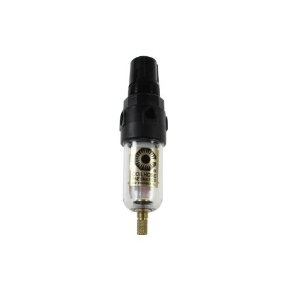Have you got water in the compressed air lines, or dripping out of the air tool exhaust port?
Water vapor is a by-product of compressing air.
Not to say that the compressor makes water, it’s just that the more air you cram into a small space like the compressor tank, the greater the concentration of water vapor in that decreased size, and free water tends to condense out of that high-vapor-content compressed air into the tank.
Yes, that’s why you should drain the compressor tank after every use. Forgetting to do so will, besides create a rust risk in the tank, allow water to build up in the tank and then blow out the discharge line, through the regulator, and down the air line to your air tools.

Water in the compressed air lines – what can you do?
Well, besides draining the tank after every use, and installing a device like you see above (more on that in a bit), a better understanding of what is happening in the air line from the tank to your air tool will help, as will understanding the impact of the local humidity on the amount of water building up in your compressor tank.
If you are using your air compressor on a hot and humid day, your compressor will have more water in the tank than if you were using the same compressor on a cool, non-humid day. Humid air has lots more water in it than cool, dry air, and driving that hot and humid air into the compressor tank ensures that more water vapor will condense out in the tank as free water. You risk that water being blown down the line to your tool.
Then, as the air from the compressor tank moves down the air line to your air tools, the compressed air cools. As that air cools, it allows water to convert from vapor to free water in the air line. As a result, you might find water dripping out of the air tool.
Or, if you are spray painting, your work piece will end up with a lot of fish eyes due to the water spraying out with the paint.
Filter and regulator
A smaller, home workshop air compressor likely came equipped with an air regulator.
It should also have come equipped with a compressed air filter, also known as a water trap. It didn’t we suspect because in their drive to bring you the cheapest air compressors on the market, adding a compressed air filter would increase the cost.
The photo of the device earlier is that of a combination filter / regulator. The air from the tank enters the filter part of the device first, removing any debris and free water from the air stream, and then blows on through the regulator, and then down to the air line. Any free water coming from the tank will be taken out of the air stream by the filter at the tank.
You might also decide to add an in-line filter upstream from the regulator since your compressor already has the regulator.
Another filter?
That will not deal with water than condenses in the air hose, however.
Think about it. An air hose full of warm, moist air is likely sitting on the cold floor of the garage or basement. That will quickly cool the air in the hose, and lots of water will condense out in the hose.
If you are experiencing that, mount another filter on the wall near the work bench, plumb the air line from the compressor into that filter, and add a short air line from the filter to the workbench so you have air for your air tools that has had even more water removed from it.
That will take care of most of the water issues.
Still water dripping out of the air tool?
If you still have water dripping from the air tool, it’s likely that there is enough warm, wet compressed air getting to the tool, and since moving air cools, operating the air tool is – in effect – cooling the compressed air, and you are still getting water vapor condensing in, and dripping out of, the air tool.
That being the case, you’ll need to add an in-line desiccant air dryer just before the air tool. That will strip all remaining water and water vapor from the compressed air stream, and should resolve the dripping water syndrome.
Comments or questions? Use the form below.

Some of my air lines when using water is coming with the air. What should i do.
Ali, we’ve moved your question to the page that will help in answering your question. Have a look, and if you have any further questions, please feel free.